The Red-Footed Tortoise is native to South America and is known for its bright yellow, orange, and red markings.
They are curious, outgoing, and courageous!
This tortoise makes an excellent pet because of their unique personalities and ease of care.
However, if you do decide to adopt this pet, you are making a lifelong commitment. They can live for 50 to 90 years in captivity and require very large outdoor pens.
If you want to learn more about how to feed, house, and care for this medium-sized tortoise then read our care guide below…
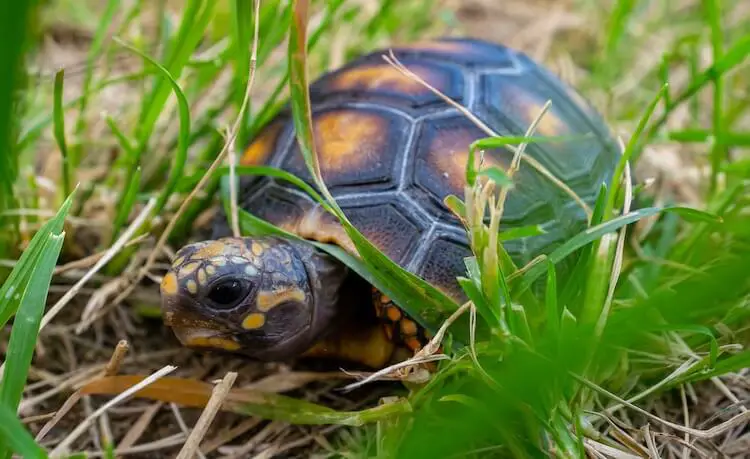
Red-Footed Tortoise Overview
Red-Footed Tortoises are native to grasslands and forests of Central and South America.
They have a broad geographic range and can be found from the eastern Andes to Brazil, Bolivia, and Argentina.
Just one of three tortoise species found in South America they are critical to the rainforest ecosystems they inhabit.
Through eating fruits and excreting the seeds, these tortoises help to disperse seeds all over the forest floor.
This tortoise is known by herpetologists for the little red scales on their legs (giving them their name). They have beautiful shell patterning that is mostly dark-brown or black, with yellow accents.
They are sociable and enjoy being raised in pairs or small groups.
However, before adopting too many, it is best to construct a large pen and stock up on substrate, greens, and other necessary items.
They will need a lot of space to roam and graze regardless of if they are housed indoors or outdoors. If kept indoors they will need both UVB lighting and a basking spot (more on this in the habitat section).
What We Like About This Tortoise
The red-footed tortoise is one of the most popular species of pet tortoise.
They thrive in captivity and are best suited to people who maintain a daily schedule and want a life-long friend – they can live for up to 90 years.
Pros
- Bright and unique colorations.
- Curious and outgoing personalities.
- Inexpensive and readily available.
Cons
- Require a large outdoor enclosure.
- Humidity requirements can sometimes be difficult to maintain.
- Shell is prone to harboring bacteria if not cleaned properly.
Species Appearance
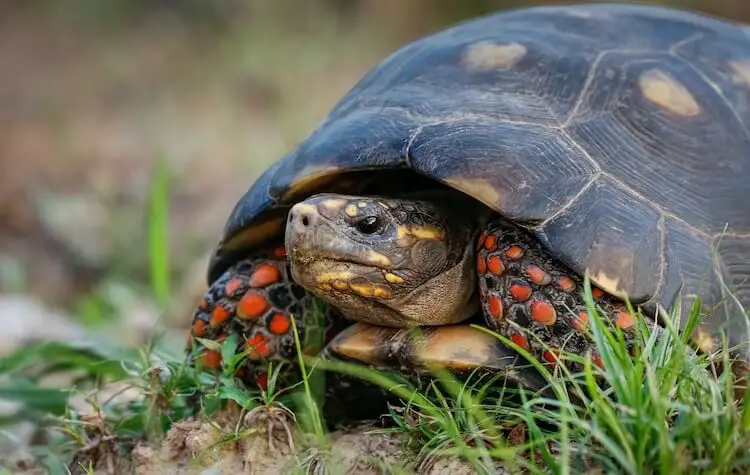
The Red-Footed Tortoise gets its name from the unique red, orange, and yellow markings found on not only its feet but also its legs, head, and tail.
These bright colorations are one of many reasons for why they are popular.
How Big Do Red-Footed Tortoises Get?
These tortoises grow to an adult length of 11 to 14 inches and weigh 20 to 30lb by the time they are ten years old. However, the largest documented red-foot surpassed two feet and weighed 60 pounds.
Hatchlings are around two inches in length and weigh two ounces.
They have a growth rate of one to two inches per year.
These tortises are sexually dimorphic, males are typically larger than females, have a more concave shell, and a longer tail. Males also have a wider anal notch that allows them to swing their heavier tail back and forth.
Color Variations and Markings
They typically have dark brown to black shells with each scute having a lighter center and a darker periphery.
Their scutes have dark-brown edges and pale-gold middles – the opposite of Russian Tortoises.
This tortoise’s dark, almost black skin, highlights the reddish markings found all over its body.
Their red markings vary greatly in amount and location and are influenced by geographic location, genetics, and diet.
Red-Footed Tortoise Care
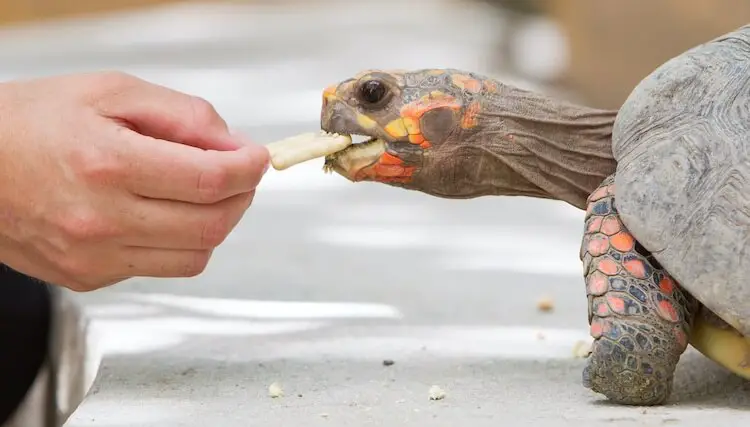
Red-Footed Tortoise Diet
In the wild they are primarily herbivores and eat a diet consisting of various grasses, leafy plants, flowers, fungi, and fruits. Very occasionally they may snack on small slow-moving invertebrates (e.g. slugs and snails).
They usually graze on greens every day but only need animal protein once a week. Lean meat or cat food can be used for animal protein but should only be fed in one ounce servings weekly. If you are unable to find cat food you can use boiled chicken, earthworms, slugs or snails.
Red-Footed Tortoises forage for their meals and will often stuff themselves before taking an extended rest.
A good rule to follow when preparing their food is:
- 60% greens
- 30% fruits
- 10% vegetables
Generally the amount of greens you feed should equal their body-size.
Feed them on a daily basis at the same time each morning.
Each tortoise has a different appetite so you will need to adjust their diet based on how much they eat. To prevent obesity remove any food left after one hour of eating.
They are not very picky eaters and eat a wide variety of foods.
Follow the 60/20/10 rule, while varying the types of greens, fruits, and vegetables you feed, and they will be healthy.
The only supplement they need is a calcium powder sprinkled on their greens once or twice a week.
Finally, tortoises need a large shallow water dish or small pond for soaking and drinking. They tend to defecate while soaking, so it is important to change the water daily to prevent bacteria from building up.
What Fruits Can A Red-Footed Tortoise Eat?
They love tropical fruits such as bananas, mangos, and papayas, but you can also feed them apples, pears, pineapples, and plums.
Good vegetables to add to their diet include squash, pumpkin, and carrots.
The best greens for tortoises include turnip greens, collard greens, dandelion greens, kale, and cabbage. Iceberg lettuce should be avoided as it has very little nutritional value.
How Long Do Red-Footed Tortoises Live?
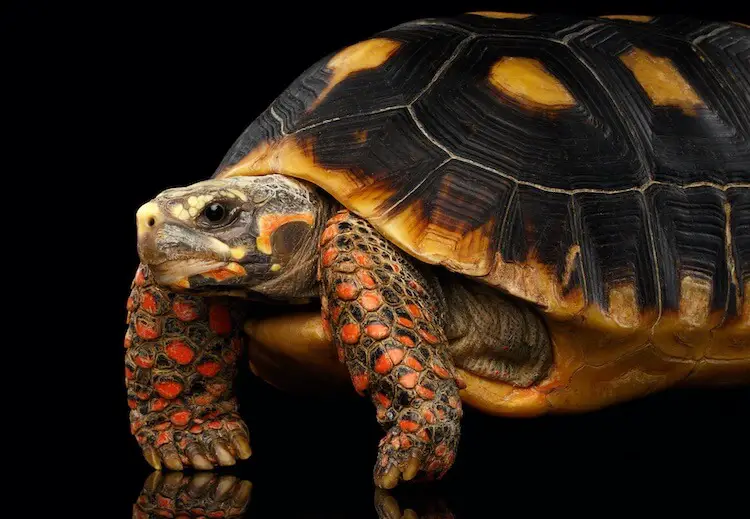
In the wild they live for 20 to 40 years. However, in captivity they have an extremely long lifespan and often surpass 50 years – some have lived over 80 years old.
They are usually healthy if raised in a proper and clean enclosure, are fed a correct diet and have annual vet check-ups.
There are some health problems and several common injuries that owners should be aware of.
Injuries can include surface cuts, overgrown toenails, and cracked beaks.
- Small laceration and abrasions from household items. If these cuts develop clean with warm water and non-scented soap daily.
- Overgrown nails occur if they are not raised on proper substrate. Toenails can be worn down with a dirt substance or can be clipped using dog nail clippers.
- Beak cracks are common and typically aren’t of major concern. Feeding your tortoise on a rough surface can help to keep it trimmed.
Several illnesses can result from poor husbandry. Stress, low temperatures, and an unclean enclosure can cause Red-Footed Tortoises respiratory infections, shell rot and parasites:
- Wheezing sounds generally characterize respiratory infections.
- Shell rot is an indication that bacteria is eating away at their shell.
- Parasites can either be internal or external and may be visible in feces.
If any of these conditions occur you should consult with your vet.
Signs They Are Healthy
- Bright, alert, and active with a healthy appetite.
- Clear skin free of irregularities.
- Clear urine and white soft urates.
- Firm, dry and well-formed feces.
Sickness Symptoms
- Lethargy, non-responsive and lack of appetite.
- Patchy, flaky, and dry skin.
- Sunken eyes.
- Discharge from eyes, ears, nose, or mouth.
Red-Footed Tortoise Enclosure
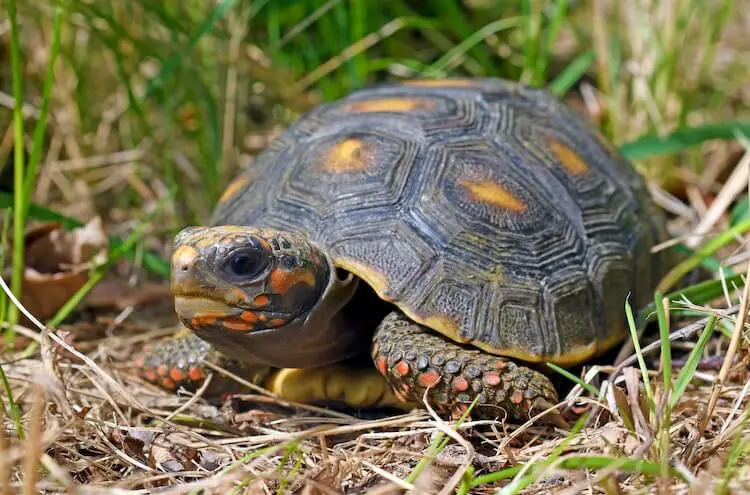
This tortoise thrives in a variety of habitats found throughout South America and several Caribbean islands.
They can be found in rainforests, temperate forests, dry thorny forests, grasslands, and savannas.
This species likes habitats with high humidity, moderate temperatures and lots of cover. They need plenty of soil available for burrowing purposes and will avoid mud because it is hard to burrow in.
Providing them with high humidity can be challenging in captivity but is critical for them to remain healthy.
In captivity they will need a lot of room to roam and graze, a basking spot and plenty of UVB lighting.
It is important for them to have a large enclosure with plenty of enrichment and stimulation.
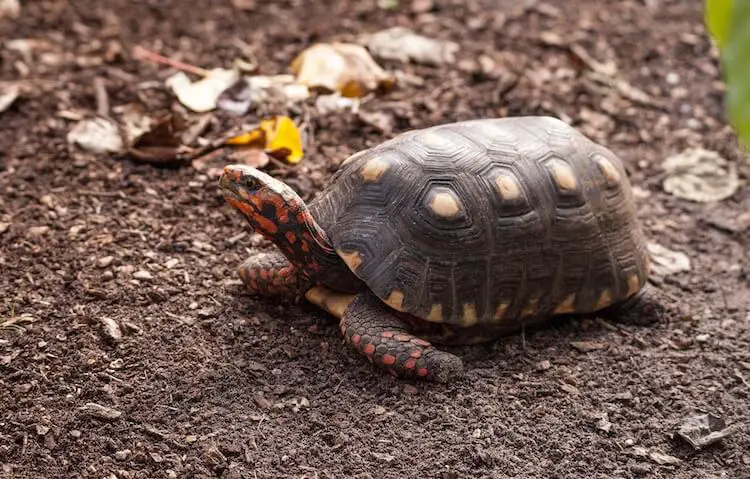
What Size Cage Does A Red-Footed Tortoise Need?
50-gallon plastic or glass tanks are recommended for hatchlings and juveniles. Once your tortoise starts to approach their adult size (after six years) it will need much more room to roam. A 30 to 40 square feet indoor or outdoor pen should be constructed.
Rocks and driftwood should be included for tortoises to climb over.
Live nontoxic plants can also be included but should be potted because they will destroy them otherwise.
These tortoises do best in outside pens with a wire roof and walls 2 feet tall that go at least six inches below ground.
The walls of the enclosure need to be sturdy otherwise they will escape.
- Tank Type: outdoor pen.
- Tank Size: 6ft x 6ft minimum.
- Lighting: UVB required.
- Substrate: cypress mulch.
Tortoises need exposure to UVB light in order to process calcium.
If your tortoise is kept in an outdoor enclosure they will obtain UVB from the sun. If they are kept indoors you must provide a 10% fluorescent UVB lightbulb. The lightbulb should be between 24 inches away from the enclosure and changed yearly.
The daytime enclosure temperature should be between 80 and 85 degrees and they will also need a designated basking spot over 90 degrees.
A basking bulb should be used for the basking spot.
If the temperature drops below 80°F in the daytime use a ceramic heater. Be careful not to use anything your tortoise can burn themselves on.
Their night time temperature should be between 70 and 75 degrees. Never let the temperature drop below 70°F because they will be at risk of hypothermia.
Red-Footed Tortoises need humidity between 50% and 70%. If a moist dig box is provided they can regulate their own humidity. Another good way to increase humidity is to include various mosses.
Because these tortoises like to dig, a sphagnum moss, cypress bark, or orchid bark substrate is a good balance of burrow-ability and humidity retention.
Naturalistic substrates are preferred as absorb moisture very well.
Cleaning & Misting
Their enclosures can quickly become contaminated if not properly maintained because of their high humidity requirements.
Excess food should be removed from their enclosure within an hour of feeding.
Spot clean waste and the water pan daily. You can also mist the enclosure when changing their water to help increase the humidity,
Once a week rocks, logs, their water dish, and anything else in their enclosure should be scrubbed with warm water and soap.
Finally, change the substrate once a week to prevent funky growth.
Typical Behavior
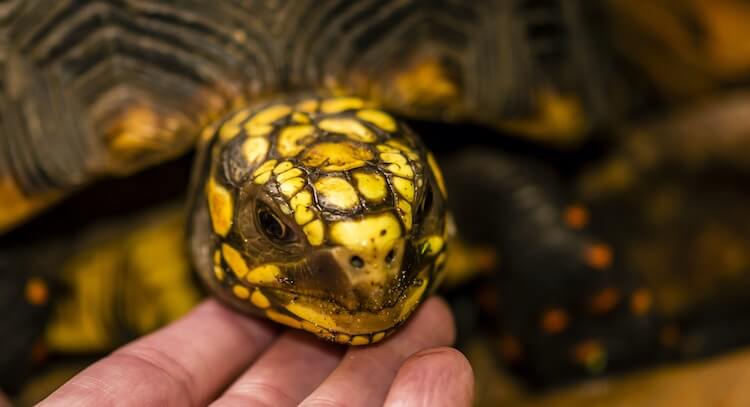
Not much is known about them in the wild. Most of their behaviors have been observed from captivity.
Unlike other desert breeds of tortoise the red-foot is active during the daytime. They spend most of the day grazing on grasses and other plants, burrowing and basking.
Basking, roaming, grazing, soaking, climbing, and digging is how happy Red-Footed Tortoises spend most of their time.
Occasionally they remain quite still following a large meal. Do not be alarmed if your tortoise isn’t very active for a few hours.
They love to explore and are extremely curious. They can remember the location of water sources, fruit trees, and other resources.
This pet is not territorial and only show signs of aggression during mating season, with males fighting each other for females.
They communicate with one another through a serious of clucks. These clucks are especially prominent during courtship and mating.
Another typical behavior is head bobbing. Unlike humans tortoises lack a flexible diaphragm. They must bob their heads to pump their throat when breathing in air.
Is A Red-Footed Tortoise A Good Pet?
Yes. They have courageous and large personalities.
However, they do not enjoy being handled. They rarely bite, but if they do their strong jaws produce a painful bite.
It takes them a while to become comfortable in their new environment. They can also be shy at first.
Allow them a few weeks to adjust to their environment before trying to interact.
If you must handle your tortoise, make sure to use two hands to support its plastron and keep it low to the ground.
Always wash your hands before and after handling them.
How Much Does A Red-Footed Tortoise Cost?
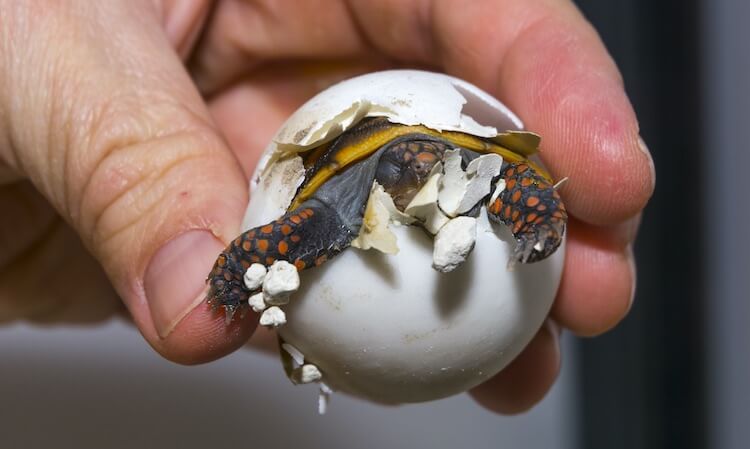
The Red-Footed Tortoise normally costs $150 to $300.
Before purchasing from pet shops first check local rescue groups and wildlife centers. Many are abandoned or looking to be rehomed because of their long lifespans.
If you do decide to purchase a baby, make sure you only buy from a reputable breeder, and ensure it is captive-bred. Their wild population is endangered and declining.
A healthy tortoise should be alert, have clear eyes and fecal vent, and have a smooth shell.
You should conduct a physical exam on the tortoise, checking its orifices for discharge and ensuring that its skin and shell are free of irregularities.
The cost of setting up an enclosure can vary greatly depending on the enclosure. An outdoor enclosure usually will cost less than keeping them indoors, since that immediately requires UVB lighting, a basking bulb, and other artificial heat sources.
| Red-Footed Tortoise Facts | |
|---|---|
| Scientific Name | Chelonoidis carbonaria |
| Price | $150 to $300 |
| Size | 11 to 14 inches |
| Lifespan | 50 to 90 years |
| Diet | Greens, fruits and vegetables |
| Tank Size | Minimum 6ft x 6ft |
| Humidity & Temperature | Daytime temperature: 80℉ – 85℉ Basking Spot: >90°F Humidity: 50% – 70% |
| Popular Alternatives | Yellow-Footed Tortoise, Russian Tortoise, Sulcata Tortoise |
Summary
The Red-Footed Tortoise is best suited for someone who is ready to make a lifelong commitment to a hardy, personable and intelligent reptile.
Their extensive lifespan makes them appealing to owners looking for a lifelong friend.
They are beautiful pets with red scales and a nice brown shell with gold accents.
Once given a large outdoor pen with space to roam and explore they only need daily feeding and annual vet check-ups to keep them healthy.
If you want a medium sized tortoise with striking red markings, a curious nature, and a vivacious appetite then look no further!
Let us know what you think below.



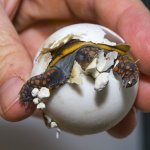
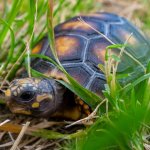

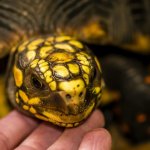
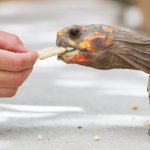
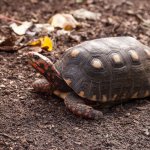
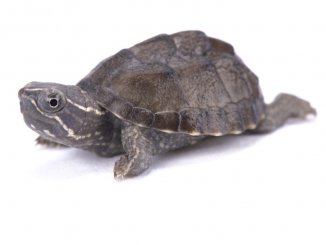
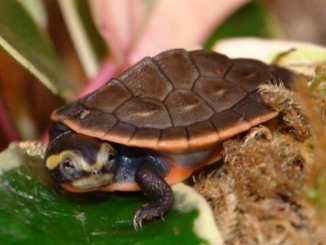
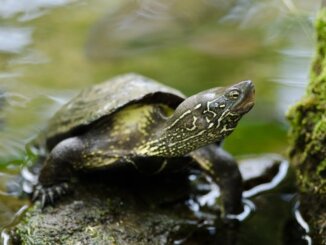

I have a 2 yr old female red footed tortoise and she has been biting at her own front legs. This is very concerning to me. Am I doing something wrong.
Hey, simply wash your tortoise using Colgate spread and scrub using new toothbrush. Scrub all over the front and back legs gently.
Make sure u use warm water for rinsing. Using spray settings highly recommended. Do it every other day . Also make sure to clean the poop right away as tortoise have tendency to eat it. It may stuck to their front legs And that’s why try to eat and eventually biting .
Do it let me know 👍👍
Amazing and very informative article. My middle school age daughter wants this species of tortoise as a pet. This article is going to helps use make a well informed decision. Thanks for sharing this valuable information!
I’m glad this helped! This and other tortoise species are very interactive, with great personality and overall a fun animal to grow up with.